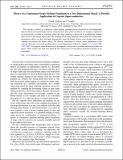Theory of a Continuous Stripe Melting Transition in a Two-Dimensional Metal: A Possible Application to Cuprate Superconductors
Author(s)
Mross, David Fabian; Todadri, Senthil
DownloadMross-2012-Theory of a Continuous Stripe Melting.pdf (221.6Kb)
PUBLISHER_POLICY
Publisher Policy
Article is made available in accordance with the publisher's policy and may be subject to US copyright law. Please refer to the publisher's site for terms of use.
Terms of use
Metadata
Show full item recordAbstract
We construct a theory of continuous stripe melting quantum phase transitions in two-dimensional metals and the associated Fermi surface reconstruction. Such phase transitions are strongly coupled but yet theoretically tractable in situations where the stripe ordering is destroyed by proliferating doubled dislocations of the charge stripe order. The resulting non-Landau quantum critical point has strong stripe fluctuations which we show decouple dynamically from the Fermi surface even though static stripe ordering reconstructs the Fermi surface. We discuss connections to various stripe phenomena in the cuprates. We point out several puzzling aspects of old experimental results [G. Aeppli et al., Science 278 1432 (1997)] on singular stripe fluctuations in the cuprates, and provide a possible explanation within our theory. These results may thus have been the first observation of non-Landau quantum criticality in an experiment.
Date issued
2012-06Department
Massachusetts Institute of Technology. Department of PhysicsCitation
Mross, David, and T. Senthil. “Theory of a Continuous Stripe Melting Transition in a Two-Dimensional Metal: A Possible Application to Cuprate Superconductors.” Physical Review Letters 108.26 (2012): 267001. © 2012 American Physical Society.
Version: Final published version